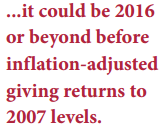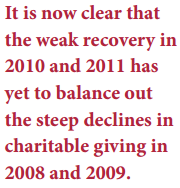It has now been more than four years since the economic crisis that came to a head in the fall of 2008. Since that time there have been numerous reports outlining the impact on charitable giving of what has been termed the Great Recession.
As most in the nonprofit world are painfully aware, it is now clear that the weak recovery in 2010 and 2011 has yet to balance out the steep declines in charitable giving in 2008 and 2009 reported by Giving USA and other sources.
While there has been improvement in giving totals, individual giving in 2011 was still 14 percent below the 2007 peak, and the editors of Giving USA have estimated it could be 2016 or beyond before inflation-adjusted giving returns to 2007 levels.
Sharpe Group consultants have just completed an in-depth analysis of a number of data sources and have discovered some critical information that sheds additional light on recent changes in giving.
IRS data reveal source of declines
Newly released IRS figures summarizing itemized deductions in recent years are among the most helpful information in understanding giving trends. Over the past 15 years, more than 80 percent of individual gifts announced by Giving USA were reported to the IRS as itemized deductions. According to the editors of Giving USA, the IRS data serve as a primary reality check for Giving USA initial giving estimates.
Sharpe consultants found some fascinating information when they cross checked IRS deduction data against income level:
- Nearly 90 percent of the decline in individual giving during the worst of the crisis (2007 through 2009) can be traced to donors with incomes of $200,000 or more who reduced their giving by 34 percent during the depths of the Great Recession.
- Those reporting incomes under $200,000, on the other hand, reduced their giving by just 4.3 percent during the same period.
- Further, donors in the $100,000 to $200,000 income range reduced their giving in the same period by less than one-half of one percent.
 This third group of donors, who are not considered wealthy by many, are among the most dependable in their giving. Additional research shows those in this income range tend to be relatively older, make gifts from disposable income, and are less likely to have been unemployed during the economic downturn.
This third group of donors, who are not considered wealthy by many, are among the most dependable in their giving. Additional research shows those in this income range tend to be relatively older, make gifts from disposable income, and are less likely to have been unemployed during the economic downturn.
Sharpe research revealed a similar trend during the Great Depression of the 1930s, when the deepest giving declines were among the wealthy, while others who continued to work and itemize tax deductions gave a higher percentage of their income to charity than during earlier years of prosperity.
Riding the stock gift rollercoaster
Another important discovery by Sharpe consultants concerns trends in giving by type of property. Between 2007 and 2009, gifts of cash fell just 9.7 percent while gifts of securities and other non-cash property plummeted along with investment markets by 46 percent, accounting for the bulk of the decline in overall giving by individuals.
On the positive front, although 2011 deduction data are not yet available, IRS reports indicate that 2010 was a year of recovery for giving. Further, the underlying trends that characterized the prior two years appear to have reversed.
Those with incomes under $200,000 increased their giving by just 2.3 percent in 2010, while taxpayers with incomes of $200,000 or more increased their giving by 17 percent. Likewise, gifts of cash were up 3.8 percent while gifts of non-cash property increased 39 percent, more than 10 times the rate of recovery of cash giving.
What to do now

How can this information help guide us as we look forward to the last quarter of 2012? First and foremost, remember that the recovery in giving thus far has apparently been led by donors with incomes over $200,000 who have once again begun making larger gifts in the form of stock and assets other than cash.
The Dow is now over 13,000, at levels not seen since 2007. As a result, donors who bought stocks at the 2009 low point in the 6,500 range now enjoy appreciation of 100 percent or more. Others have seen stocks they have owned for many years return to previous values.
Now is the time to share with higher-level donors—who led the decline in giving and must continue to lead the recovery—the wisdom of making larger gifts before the end of this year, with special emphasis on gifts of appreciated securities.
Neutralize toxic tax advice
It is also vitally important to help donors understand why they should not listen to ill-considered recommendations advising them to wait until next year to make significant gifts. Some unidimensional commentators have suggested delaying gifts until next year when tax rates are scheduled to rise and charitable deductions will be “worth” more.
There are at least three major reasons why well-informed donors should not follow recommendations to delay larger gifts until next year:
First – Whether or not tax laws change, there is a negative cash flow impact if a charitable gift is delayed until 2013. Delaying gifts will result in more taxes on the income not donated in 2012, while savings from a deduction for a gift next year will be delayed until April of 2014.
Second – Both political parties have proposed tax law changes that would limit the future value of all deductions, including charitable gifts. One of the most often proposed changes would limit the value of charitable gift deductions to the 28 percent tax bracket. This means a person in the 35 percent tax bracket would save $3,500 in taxes for a deductible $10,000 gift in 2012, but just $2,800 if this limit is imposed for 2013. This would mean a 25 percent increase of $700 in the after-tax cost of the gift.
Third – even if tax rates are higher next year and deductions are not limited, no one knows what stock market values will be next year. Because donors can deduct the full value of securities to reduce tax on income, the possibility of a reduction in market values next year may more than offset any possible value gained by waiting to make gifts until next year.
It boils down to this: Donors in higher tax brackets need to know that the old adage “a bird in the hand…” may well apply to their charitable gift plans this fall.
For more information, including additional analysis and supporting data, see “Will Things ever Be the Same?” at www.sharpenet.com/resources.

